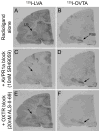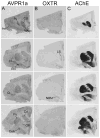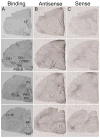Neuroanatomical distribution of oxytocin and vasopressin 1a receptors in the socially monogamous coppery titi monkey (Callicebus cupreus)
- PMID: 24814726
- PMCID: PMC4083847
- DOI: 10.1016/j.neuroscience.2014.04.055
Neuroanatomical distribution of oxytocin and vasopressin 1a receptors in the socially monogamous coppery titi monkey (Callicebus cupreus)
Abstract
The coppery titi monkey (Callicebus cupreus) is a socially monogamous New World primate that has been studied in the field and the laboratory to investigate the behavioral neuroendocrinology of primate pair bonding and parental care. Arginine vasopressin has been shown to influence male titi monkey pair-bonding behavior, and studies are currently underway to examine the effects of oxytocin on titi monkey behavior and physiology. Here, we use receptor autoradiography to identify the distribution of arginine vasopressin 1a receptor (AVPR1a) and oxytocin receptors (OXTR) in hemispheres of titi monkey brain (n=5). AVPR1a are diffuse and widespread throughout the brain, but the OXTR distribution is much more limited, with the densest binding being in the hippocampal formation (dentate gyrus, CA1 field) and the presubiculum (layers I and III). Moderate OXTR binding was detected in the nucleus basalis of Meynert, pulvinar, superior colliculus, layer 4C of primary visual cortex, periaqueductal gray (PAG), pontine gray, nucleus prepositus, and spinal trigeminal nucleus. OXTR mRNA overlapped with OXTR radioligand binding, confirming that the radioligand was detecting OXTR protein. AVPR1a binding is present throughout the cortex, especially in cingulate, insular, and occipital cortices, as well as in the caudate, putamen, nucleus accumbens, central amygdala, endopiriform nucleus, hippocampus (CA4 field), globus pallidus, lateral geniculate nucleus, infundibulum, habenula, PAG, substantia nigra, olivary nucleus, hypoglossal nucleus, and cerebellum. Furthermore, we show that, in the titi monkey brain, the OXTR antagonist ALS-II-69 is highly selective for OXTR and that the AVPR1a antagonist SR49059 is highly selective for AVPR1a. Based on these results and the fact that both ALS-II-69 and SR49059 are non-peptide, small-molecule antagonists that should be capable of crossing the blood-brain barrier, these two compounds emerge as excellent candidates for the pharmacological manipulation of OXTR and AVPR1a in future behavioral experiments in titi monkeys and other primate species.
Keywords: monogamy; neuroanatomy; neuropeptides; nonhuman primate; pair bonding; receptor binding.
Copyright © 2014 IBRO. Published by Elsevier Ltd. All rights reserved.
Figures






References
-
- Albers HE. The regulation of social recognition, social communication and aggression: vasopressin in the social behavior neural network. Hormones and Behavior. 2012;61:283–292. - PubMed
-
- Beery AK, Lacey EA, Francis DD. Oxytocin and vasopressin receptor distributions in a solitary and a social species of tuco-tuco (Ctenomys haigi and Ctenomys sociabilis) J Comp Neurol. 2008;507:1847–1859. - PubMed
-
- Beery AK, Zucker I. Oxytocin and same-sex social behavior in female meadow voles. Neuroscience. 2010;169:665–673. - PubMed
Publication types
MeSH terms
Substances
Grants and funding
- P51 OD011132/OD/NIH HHS/United States
- R21 MH090776/MH/NIMH NIH HHS/United States
- P51OD011132/OD/NIH HHS/United States
- HD053555/HD/NICHD NIH HHS/United States
- R01 HD053555/HD/NICHD NIH HHS/United States
- P51RR000165/RR/NCRR NIH HHS/United States
- 1P50MH100023/MH/NIMH NIH HHS/United States
- P51OD011107/OD/NIH HHS/United States
- T32MH073525-06/MH/NIMH NIH HHS/United States
- P51 OD011107/OD/NIH HHS/United States
- T32 MH073525/MH/NIMH NIH HHS/United States
- P50 MH100023/MH/NIMH NIH HHS/United States
- P51 RR000165/RR/NCRR NIH HHS/United States
- MH090776/MH/NIMH NIH HHS/United States
LinkOut - more resources
Full Text Sources
Other Literature Sources
Miscellaneous

